How to get to iTunes University: a step by step guide to action
Not so long ago, iTunes U was officially available for posting materials from Russian universities. Than did not fail to take advantage of Fiztech, having placed a couple of its courses there. And despite the fact that Apple itself has quite detailed manuals on this process, we have prepared this article to protect those who want to get to iTunes University from a number of errors that they themselves have committed.

In short, in order to fully place university courses in iTunes U (and someone could find them at the same time), you need to not only mark up the courses there, but also to become an authorized content provider.
Before the beginning of the description I would like to mention that in the process of work we were often surprised at how the resource works. And he works, to put it mildly, not very stable. And both on poppies with canonical safaris, and on windows with chrome. At about 10% of the hits, we either had an error or the page spontaneously reloaded. Let's leave it on the conscience of the developers from Cupertino.
')
So here we go.
To be able to access iTunes U Course Manager, you must:
No more requirements. Everyone has the opportunity to create a course, however, with some restrictions, which will be described below.
We pass on https://itunesu.itunes.apple.com , log in using your Apple ID and fill in all the information about yourself.
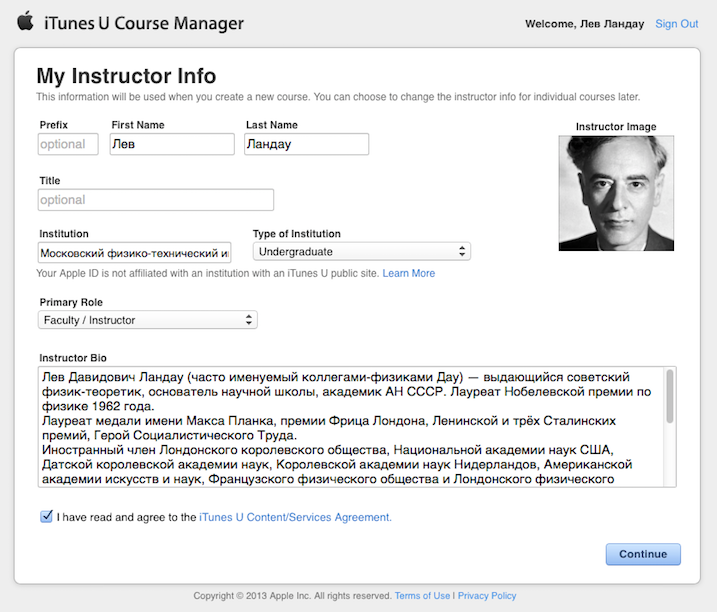
Here is the internal office. For one Apple account provides 20GB. You can increase (and, in fact, get unlimited) volume by becoming an authorized provider of content iTunes U.

During the course creation, in addition to general information, you will be required to have a high-quality logo (minimum 600x600 pixels), a course type (self-study or training with a start and end date for the course) and a license type for your Creative Commons content. For Physics and Technology, we chose the Attribution-NonCommercial-ShareAlike 3.0 license .
For the course it is necessary to create the so-called Outline (plan, outline), which will serve as the basis for all subsequent publications of educational materials. Often done weekly splitting.

The most important thing in any educational process is materials. Available for download and viewing:
Maximum upload file size is 2GB. All materials open inside the application.
You need to take into account that Apple (unlike the same Coursera) does not do any video transcoding, so if you want to place a lot of audio and video materials in your courses, you will have to think about their bitrate beforehand - as I said, more than 20GB to a private person not issued. Also, immediately it is worth thinking about people who will download content - hardly anyone will be pleased that on his ipad half of the place is full of useful media, but huge media.

The presentation of the material in iTunes U deserves special attention.
Within each Theme (or Week) you can post an unlimited number of notes. For each note, you can attach any files you previously downloaded. For video, you can specify the beginning and end of the segment that you want to play. Thus, having a great 3-hour educational film, you can download it once, and give students the right 15-minute fragments at the right time. Although, to be honest, I have met not many courses that use it.

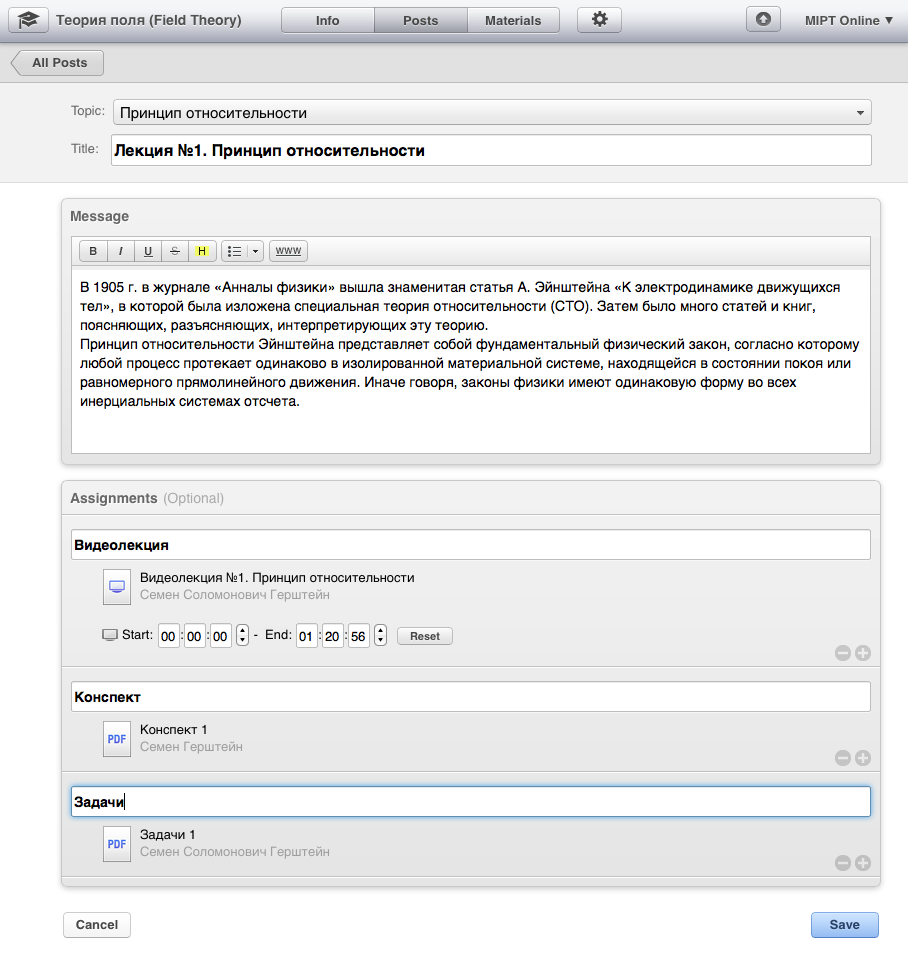
The video player is simple and at the same time functional. In addition to the standard set, there are buttons ± 15 seconds, the function of changing the playback speed 0.5-2.0x (a very important thing when watching video lectures) and notes. The latter pays a lot of attention - from the special mode for working with video, ending with brisk navigation and synchronization between devices.
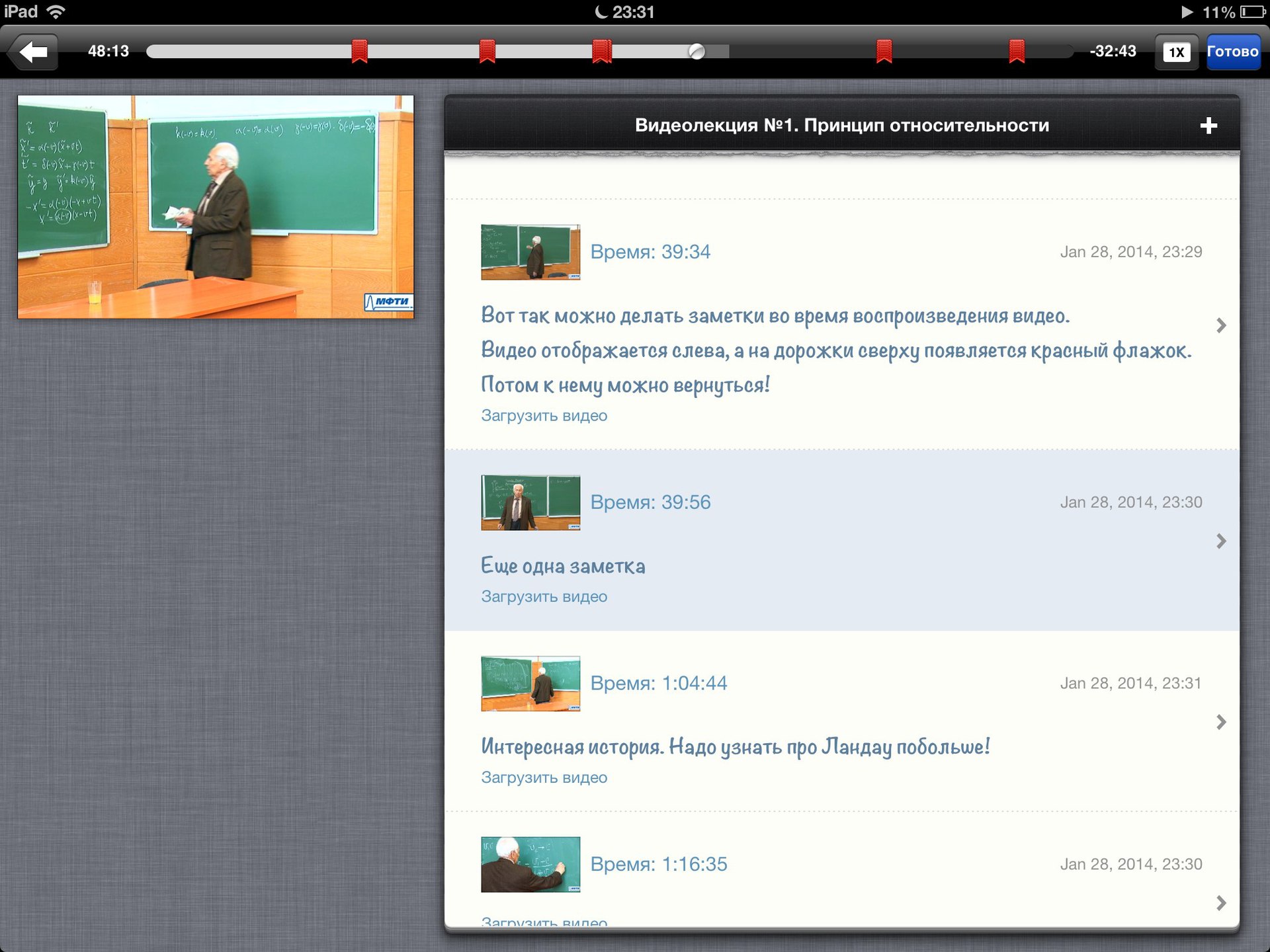
Another important point is the update speed and notification system. Everything happens almost instantly. We downloaded a new lecture, published a new note - students receive notifications immediately after clicking the “Publish” button. Very comfortably.
After the pre-registration of the course is completed, you can send everyone a link to add the course to the iOS application - no one can know about you in other ways, because only partner institutions are indexed in the application search. Moreover, on the one hand, each student will be asked if he agrees to disclose his e-mail to the course author, and on the other hand, the teacher will have to manually confirm each student for the course. If you are a private teacher and are not affiliated with a particular institute in iTunes U, you can have a maximum of 12 courses with 50 students each.
What if you want more audience reach, the ability to be in the search results, your logo on the iTunes homepage and the absence of limits on downloading materials?
To become an official provider of educational content, you need to make sure that you meet the following conditions:
If you meet these conditions, then you can act.
To do this, leave the application on http://eduapp.apple.com (just enter your Apple ID). They promise to send the answer within 5 working days. The letter with the answer, like all subsequent letters, contains a link to the progress bar of your application, which allows you to track the current stage.
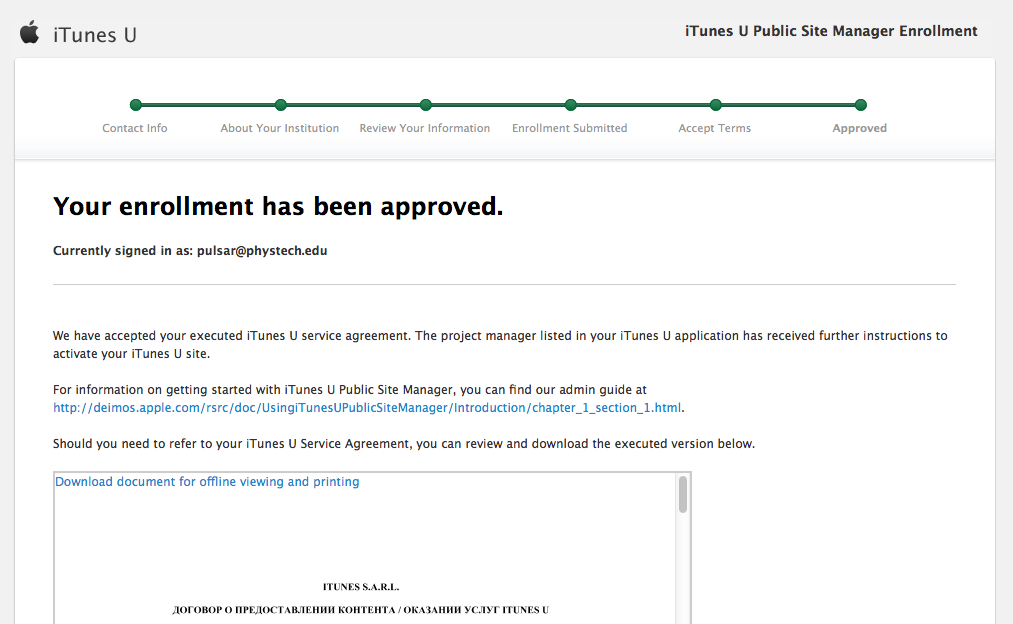
After you fill in your school details and select several contact persons with their posts, Apple verifies your details and sends you a public offer agreement that you need to electronically sign (by clicking on the “Sign” button). Unfortunately, when we try to download an Apple document, we are again happy with errors, this time “Unable to locate the file, please contact support!”. It takes up to 5 working days, and after that you get the good news that you have become the official content provider. After that, the person you specified as the project manager is given access to https://sitemanager.itunes.apple.com .
iTunes U Public Site Manager is a tool to manage your home page. Here you can customize its design for each device (iPhone, iPad or iTunes), manage widgets, courses, collections and subscribers, analyze visitor statistics and much more.
Here the possibilities of presenting the material are already greater. On the page of the Institute, you can post not only Courses, but also the so-called Collections. The latter are a set of media files that are united by one theme. Collections are convenient to use, for example, in the following cases:
If there are a lot of files, and you don’t really want to sort, the tag system comes to the rescue - it will create collections automatically.
It is worth noting that most of the materials in iTunes U are represented by collections rather than courses - because it is much easier to post media files with some tags than to structure and link them in detail in the course manager. Even the Field Theories and Thermodynamics presented by us are inherently more collections than courses, but we are working on it.
Once you have tied the courses to your home page in the appropriate tab, you need to customize the external design. You will need a 3200x600px heading and setting the location of widgets with news, download leaders, tags, etc. If desired, inside the browser, you can quickly view the layout of your page on different devices and operating systems.
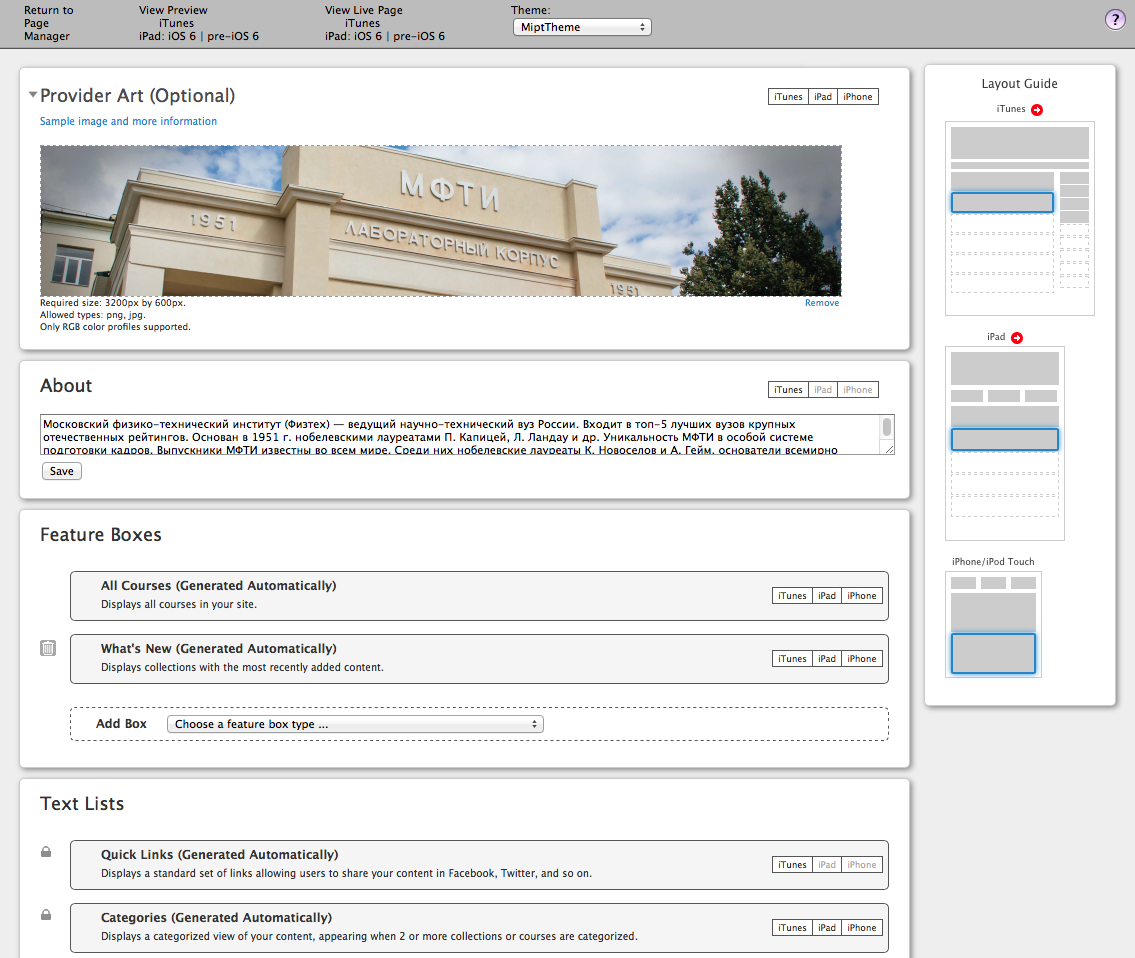
Once the design is complete, once again it is worth checking that the site meets the minimum requirements for publication:
After checking, press the button "Publish" and wait a few hours before the first publication in iTunes U! As soon as it happens, a notification will be sent. Then you can take the iPad in your hands and look for your own educational institution in the list of universities on iTunes U.
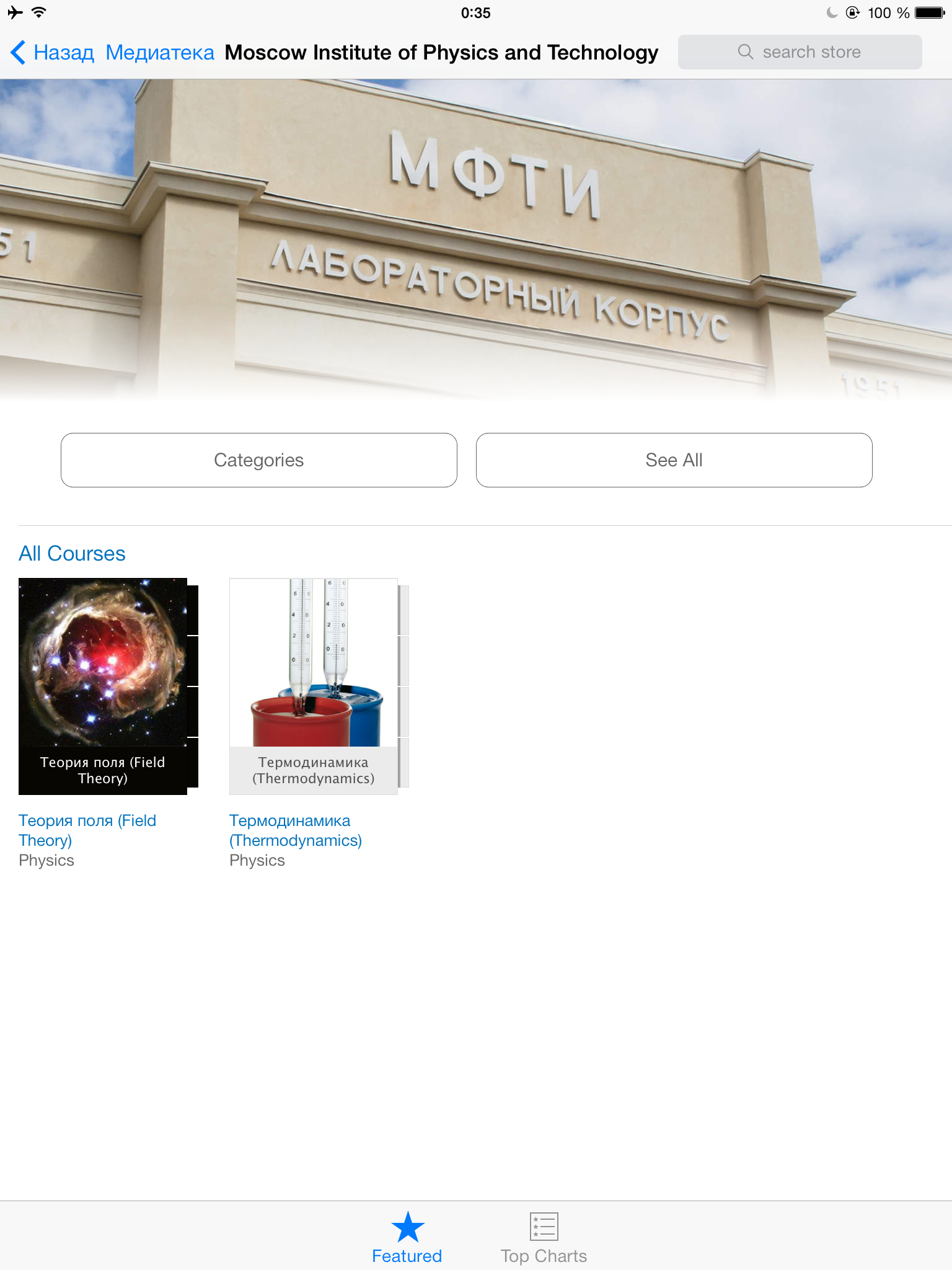
Subsequent updates of content and information on the official page occur very quickly.
Since this is the first post, I would like to briefly say what awaits you soon in this blog. In the near future, we would like to focus on a number of articles related to IT in education, having told more about what initiatives on this topic have been going on at MIPT over the last few years.
In addition, I would like to remind you that in a couple of weeks our course on the Coursera starts. In essence, this will be the first course on this resource from a Russian-speaking university. We tried very hard to make it interesting and with impatience we look forward to its beginning.
The basis for all materials used on both iTunes U and Coursera is our open MIPT Lecture Hall , which now features over 25 courses that are taught by MIPT professors and current RAS scientists. There will also be a separate article about him soon.

In short, in order to fully place university courses in iTunes U (and someone could find them at the same time), you need to not only mark up the courses there, but also to become an authorized content provider.
Before the beginning of the description I would like to mention that in the process of work we were often surprised at how the resource works. And he works, to put it mildly, not very stable. And both on poppies with canonical safaris, and on windows with chrome. At about 10% of the hits, we either had an error or the page spontaneously reloaded. Let's leave it on the conscience of the developers from Cupertino.
')
So here we go.
Add the first course
To be able to access iTunes U Course Manager, you must:
- have a working Apple ID (now even a Russian one will do),
- Safari 6+ on Mac,
- or Mozilla Firefox 12+ on a Mac or PC,
- or Google Chrome 28+ on Mac or PC.
No more requirements. Everyone has the opportunity to create a course, however, with some restrictions, which will be described below.
We pass on https://itunesu.itunes.apple.com , log in using your Apple ID and fill in all the information about yourself.

Here is the internal office. For one Apple account provides 20GB. You can increase (and, in fact, get unlimited) volume by becoming an authorized provider of content iTunes U.

During the course creation, in addition to general information, you will be required to have a high-quality logo (minimum 600x600 pixels), a course type (self-study or training with a start and end date for the course) and a license type for your Creative Commons content. For Physics and Technology, we chose the Attribution-NonCommercial-ShareAlike 3.0 license .
For the course it is necessary to create the so-called Outline (plan, outline), which will serve as the basis for all subsequent publications of educational materials. Often done weekly splitting.

The most important thing in any educational process is materials. Available for download and viewing:
- audio (mp3, m4a),
- video (mp4, m4v, mov),
- books (epub, ibooks),
- documents (pdf, rtf, doc, ppt, xls, txt, docx, xlsx, pptx, key, pages, numbers),
- applications (links to the iTunes Store)
- images (png, jpg),
- web links (http: //, https: //),
- materials from your other courses / collections.
Maximum upload file size is 2GB. All materials open inside the application.
You need to take into account that Apple (unlike the same Coursera) does not do any video transcoding, so if you want to place a lot of audio and video materials in your courses, you will have to think about their bitrate beforehand - as I said, more than 20GB to a private person not issued. Also, immediately it is worth thinking about people who will download content - hardly anyone will be pleased that on his ipad half of the place is full of useful media, but huge media.

The presentation of the material in iTunes U deserves special attention.
Within each Theme (or Week) you can post an unlimited number of notes. For each note, you can attach any files you previously downloaded. For video, you can specify the beginning and end of the segment that you want to play. Thus, having a great 3-hour educational film, you can download it once, and give students the right 15-minute fragments at the right time. Although, to be honest, I have met not many courses that use it.


The video player is simple and at the same time functional. In addition to the standard set, there are buttons ± 15 seconds, the function of changing the playback speed 0.5-2.0x (a very important thing when watching video lectures) and notes. The latter pays a lot of attention - from the special mode for working with video, ending with brisk navigation and synchronization between devices.

Another important point is the update speed and notification system. Everything happens almost instantly. We downloaded a new lecture, published a new note - students receive notifications immediately after clicking the “Publish” button. Very comfortably.
After the pre-registration of the course is completed, you can send everyone a link to add the course to the iOS application - no one can know about you in other ways, because only partner institutions are indexed in the application search. Moreover, on the one hand, each student will be asked if he agrees to disclose his e-mail to the course author, and on the other hand, the teacher will have to manually confirm each student for the course. If you are a private teacher and are not affiliated with a particular institute in iTunes U, you can have a maximum of 12 courses with 50 students each.
What if you want more audience reach, the ability to be in the search results, your logo on the iTunes homepage and the absence of limits on downloading materials?
We become the official content provider
To become an official provider of educational content, you need to make sure that you meet the following conditions:
- you represent an educational institution (university, private school, college);
- You have the right to link your institution and iTunes U contract (need to confirm your credentials).
If you meet these conditions, then you can act.
To do this, leave the application on http://eduapp.apple.com (just enter your Apple ID). They promise to send the answer within 5 working days. The letter with the answer, like all subsequent letters, contains a link to the progress bar of your application, which allows you to track the current stage.

After you fill in your school details and select several contact persons with their posts, Apple verifies your details and sends you a public offer agreement that you need to electronically sign (by clicking on the “Sign” button). Unfortunately, when we try to download an Apple document, we are again happy with errors, this time “Unable to locate the file, please contact support!”. It takes up to 5 working days, and after that you get the good news that you have become the official content provider. After that, the person you specified as the project manager is given access to https://sitemanager.itunes.apple.com .
We get the official website and publish
iTunes U Public Site Manager is a tool to manage your home page. Here you can customize its design for each device (iPhone, iPad or iTunes), manage widgets, courses, collections and subscribers, analyze visitor statistics and much more.
Here the possibilities of presenting the material are already greater. On the page of the Institute, you can post not only Courses, but also the so-called Collections. The latter are a set of media files that are united by one theme. Collections are convenient to use, for example, in the following cases:
- if there was an event (exhibition, conference, demonstration), its content does not reach the course, but it would be highly desirable to have access to it on a separate page.
- If there are only lectures in pdf that will be useful to everyone.
- Or you have several audio lessons, video presentations and books on some topics, but it’s difficult to make a course with a clear program and structural presentation of the material.
If there are a lot of files, and you don’t really want to sort, the tag system comes to the rescue - it will create collections automatically.
It is worth noting that most of the materials in iTunes U are represented by collections rather than courses - because it is much easier to post media files with some tags than to structure and link them in detail in the course manager. Even the Field Theories and Thermodynamics presented by us are inherently more collections than courses, but we are working on it.
Once you have tied the courses to your home page in the appropriate tab, you need to customize the external design. You will need a 3200x600px heading and setting the location of widgets with news, download leaders, tags, etc. If desired, inside the browser, you can quickly view the layout of your page on different devices and operating systems.

Once the design is complete, once again it is worth checking that the site meets the minimum requirements for publication:
- at least one collection or course is attached to the site;
- visible collections must have at least one element;
- The official page must contain at least one non-empty widget.
After checking, press the button "Publish" and wait a few hours before the first publication in iTunes U! As soon as it happens, a notification will be sent. Then you can take the iPad in your hands and look for your own educational institution in the list of universities on iTunes U.

Subsequent updates of content and information on the official page occur very quickly.
What will happen next
Since this is the first post, I would like to briefly say what awaits you soon in this blog. In the near future, we would like to focus on a number of articles related to IT in education, having told more about what initiatives on this topic have been going on at MIPT over the last few years.
In addition, I would like to remind you that in a couple of weeks our course on the Coursera starts. In essence, this will be the first course on this resource from a Russian-speaking university. We tried very hard to make it interesting and with impatience we look forward to its beginning.
The basis for all materials used on both iTunes U and Coursera is our open MIPT Lecture Hall , which now features over 25 courses that are taught by MIPT professors and current RAS scientists. There will also be a separate article about him soon.
Source: https://habr.com/ru/post/211448/
All Articles